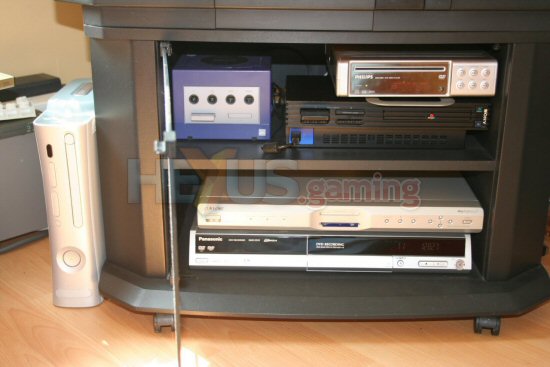Loads of SCART kit? Not a problem...
Being a gaming journo I have simply loads of stuff hooked up to my TV. I even got an electrician in to beef up the electrical wiring behind the telly and fit eight wall sockets! Besides the TV we have the Sky box, the DVD recorder, the DVD player (yes, I know its overkill to have two DVD machines), the GameCube, the PS2 and the Xbox 360. As you can imagine, it’s a cabling nightmare behind my TV and only having 2 SCART inputs and 1 composite input on my TV didn’t help.
I’d tried auto-switching SCART boxes before but seeing as games consoles don’t send a signal on Pin 8, the SCART switch doesn’t know anything is going on and doesn’t switch the signal. I had to resort to a manual box which needed to remain accessible at the side of my TV. This was fine for not needing to unplug and plug in the various consoles but it was a less than elegant solution that still left a spaghetti of wiring lying down the side of the TV.
 Click for larger image
Click for larger imageThe Smart-SCART PLUS is different. This box of tricks uses it’s built in Video-Sense technology to figure out when a device is sending a signal and then switch the output to the TV to that device. All you have to do is power up the console and away you go… at least, that’s the theory…
In practise, as heavenly as the Smart-SCART PLUS, the manual is woefully inadequate. It nicely explains what you have to do and gives you all sorts of tech specs that you really don’t need but it doesn’t answer some basic questions which, maddeningly, are actually features Bluedelta use to promote the Smart-SCART PLUS!
But we’ll come to that in a minute. First, let’s get it hooked up. The Smart-SCART PLUS video-sensing works on the principal of overriding other inputs when another device is switched on. In other words, if you’re watching something plugged into input 1 and then turn on whatever is in input 2, the display switches to input 2. Turn on input 3 and it overrides 2, input 4 overrides 3 and so on. So plug something into input 8 and regardless of whether your watching input 1, 4, or 7, what’s showing on input 8 is what you’ll see, all without having to switch off the devices on the lower numbered inputs.









